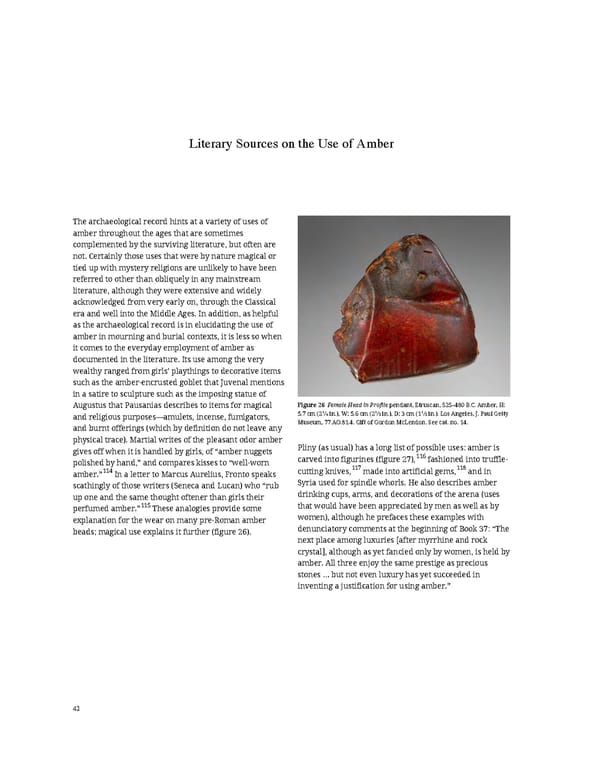Literary Sources on the Use of Amber The archaeological record hints at a variety of uses of amber throughout the ages that are sometimes complemented by the surviving literature, but often are not. Certainly those uses that were by nature magical or tied up with mystery religions are unlikely to have been referred to other than obliquely in any mainstream literature, although they were extensive and widely acknowledged from very early on, through the Classical era and well into the Middle Ages. In addition, as helpful as the archaeological record is in elucidating the use of amber in mourning and burial contexts, it is less so when it comes to the everyday employment of amber as documented in the literature. Its use among the very wealthy ranged from girls’ playthings to decorative items such as the amber-encrusted goblet that Juvenal mentions in a satire to sculpture such as the imposing statue of Augustus that Pausanias describes to items for magical Figure 26 Female Head in Profile pendant, Etruscan, 525–480 B.C. Amber, H: and religious purposes—amulets, incense, fumigators, 5.7 cm (21⁄4 in.), W: 5.6 cm (21⁄5 in.), D: 3 cm (11⁄5 in.). Los Angeles, J. Paul Getty and burnt offerings (which by definition do not leave any Museum, 77.AO.81.4. Gift of Gordon McLendon. See cat. no. 14. physical trace). Martial writes of the pleasant odor amber gives off when it is handled by girls, of “amber nuggets Pliny (as usual) has a long list of possible uses: amber is polished by hand,” and compares kisses to “well-worn carved into figurines (figure 27),116 fashioned into truffle- amber.”114 In a letter to Marcus Aurelius, Fronto speaks cutting knives,117 made into artificial gems,118 and in scathingly of those writers (Seneca and Lucan) who “rub Syria used for spindle whorls. He also describes amber up one and the same thought oftener than girls their drinking cups, arms, and decorations of the arena (uses perfumed amber.”115These analogies provide some that would have been appreciated by men as well as by explanation for the wear on many pre-Roman amber women), although he prefaces these examples with beads; magical use explains it further (figure 26). denunciatory comments at the beginning of Book 37: “The next place among luxuries [after myrrhine and rock crystal], although as yet fancied only by women, is held by amber. All three enjoy the same prestige as precious stones … but not even luxury has yet succeeded in inventing a justification for using amber.” 42
 Ancient Carved Ambers in the J. Paul Getty Museum Page 51 Page 53
Ancient Carved Ambers in the J. Paul Getty Museum Page 51 Page 53
